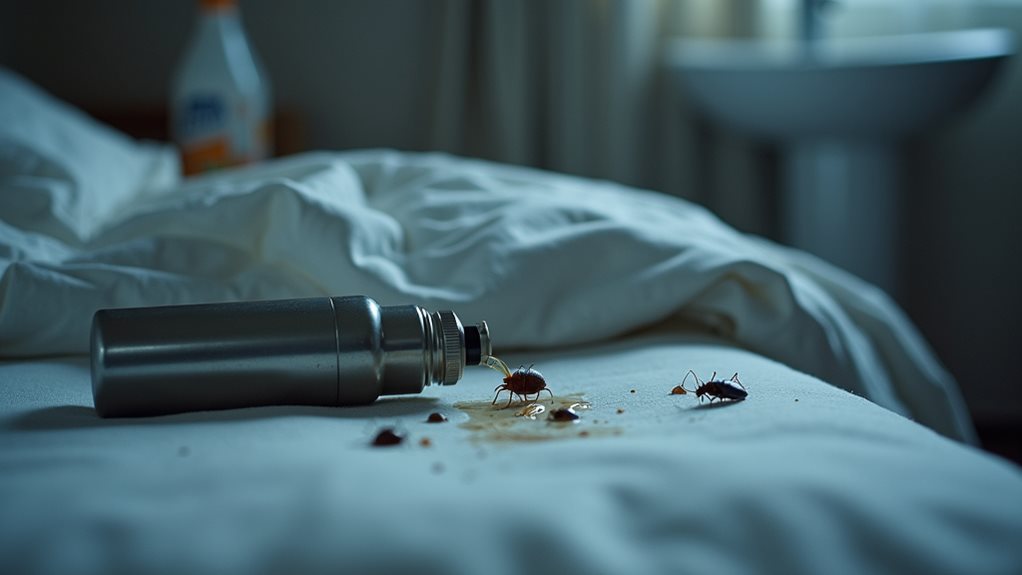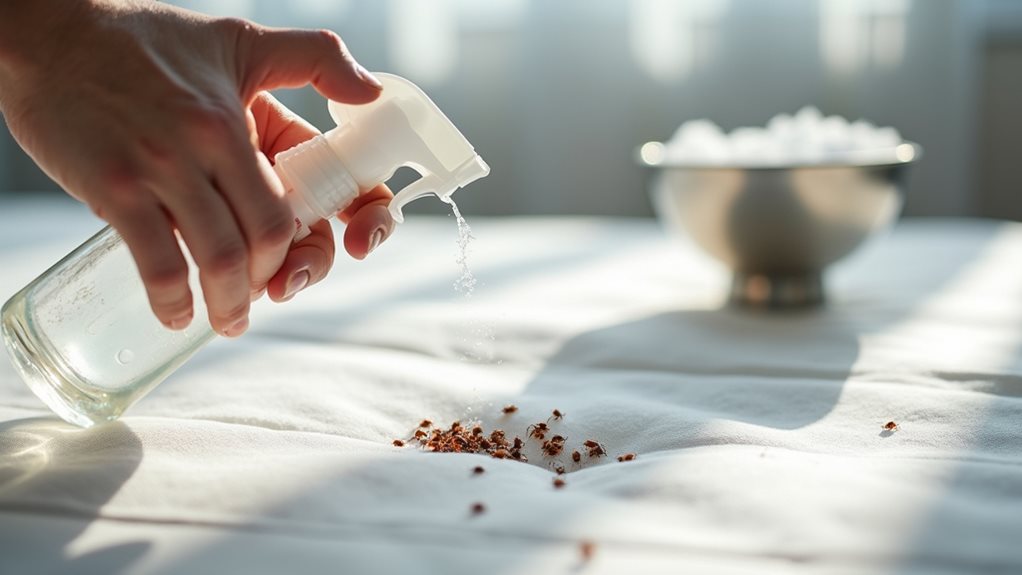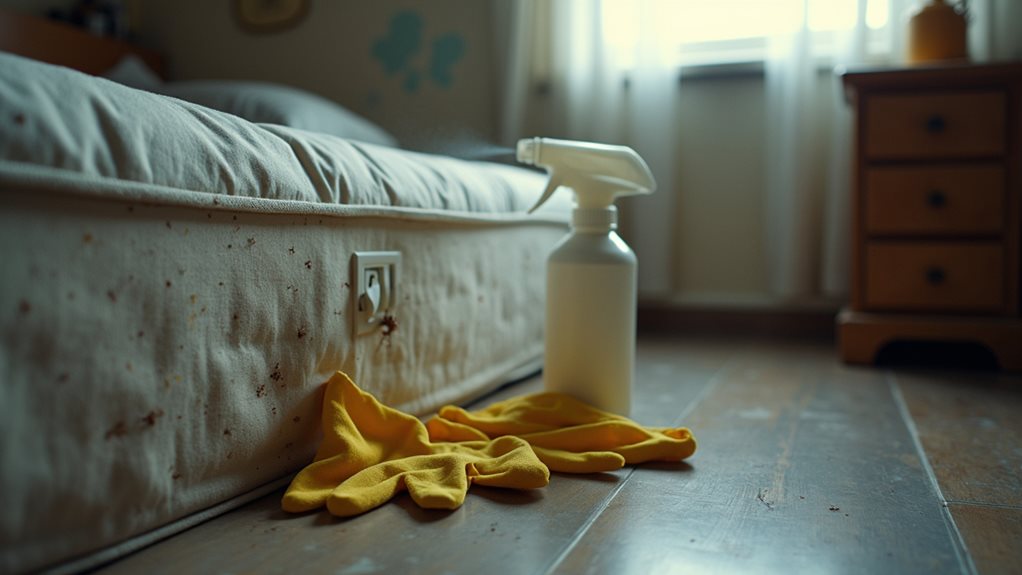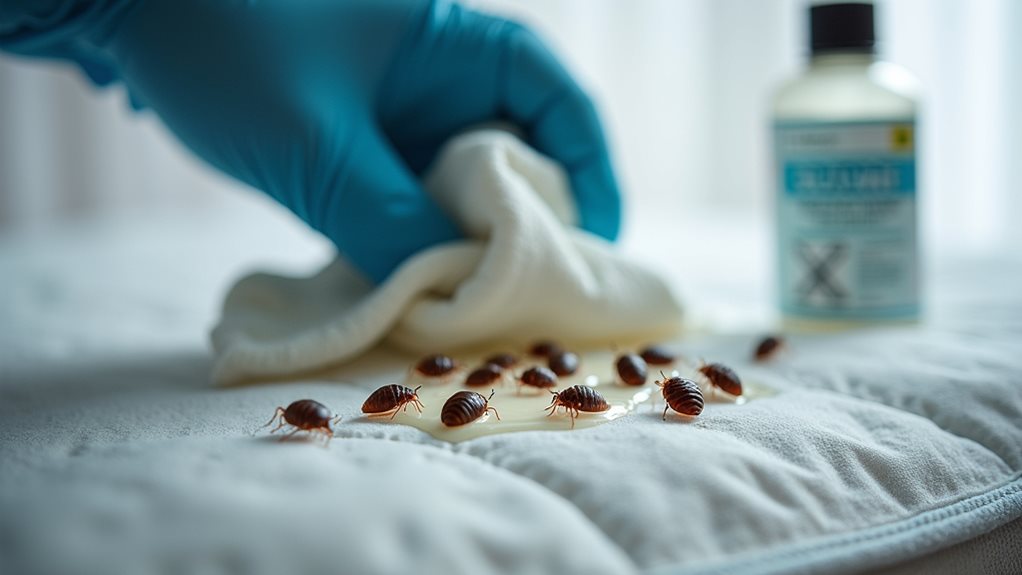You can kill exposed adult bed bugs with household bleach in seconds to under a minute if the insect is thoroughly wetted, because sodium hypochlorite rapidly oxidizes proteins and lipids and collapses the bug’s protective barrier. Eggs and sheltered nymphs need full contact and may survive brief or partial exposure, so bleach won’t reliably clear an infestation. It also damages fabrics, produces fumes, and offers no residual control, so keep that in mind if you want effective options beyond spot treatment.
TLDR
- Household bleach (5–6% sodium hypochlorite) kills exposed adult bed bugs on direct contact typically within about 10–60 seconds.
- Bleach can kill nymphs and eggs if the liquid thoroughly wets them, but partial or brief contact often fails.
- Higher bleach concentration and thorough saturation shorten kill time but increase material damage and safety hazards.
- Bleach has no residual effect and cannot reach hidden bugs in cracks, mattresses, or furniture, so many survive.
- Because of limited reach, safety risks, and surface damage, bleach alone is not recommended for treating infestations.
How Bleach Kills Bed Bugs: The Science Behind It

Because bleach contains sodium hypochlorite, a potent oxidizing agent, it can destroy bed bugs on direct contact by chemically breaking down the proteins and lipids that make up their exoskeleton and eggshells. Additionally, exposure to herbicides near water can increase the vulnerability of pests by harming their natural predators. You should know it causes oxidative damage, compromises the waxy barrier, and induces rapid dehydration and physiological collapse, but it only works where it actually touches bugs or eggs. Additionally, bleach is most effective only against individual bugs on contact and is not sufficient alone to eliminate entire infestations.
How Quickly Bleach Works on Adult Bed Bugs
When you spray or apply bleach directly to an adult bed bug, death can occur rapidly—typically within 10 to 60 seconds—because concentrated sodium hypochlorite disrupts the exoskeleton and causes lethal dehydration. Additionally, exposure to harmful substances like asbestos fibers can pose significant health risks, making it crucial to handle pest control methods safely. The exact kill time depends on the bleach concentration and how thoroughly the insect is contacted, so diluted solutions or brief, partial exposure will slow or prevent mortality.
Remember that bleach only affects bugs it touches and can damage surfaces, so its speed on adults is useful but limited by where and how you apply it. Direct contact is required for bleach to kill bed bugs, so hidden insects and eggs are likely to survive if they are not reached.
Contact Kill Time
On direct contact, household bleach (sodium hypochlorite) can incapacitate and kill adult bed bugs very quickly, typically within about 10 to 60 seconds depending on concentration and how well the solution wets the insect’s exoskeleton.
You should know the oxidizing action disrupts proteins and lipids, causing rapid dehydration and death, but only direct hits work and bugs often flee, limiting practical effectiveness.
Concentration Matters
You’ve just seen how direct contact with bleach can knock down adult bed bugs quickly; now it’s important to take into account how the strength of that bleach changes the speed and reliability of the effect.
Higher sodium hypochlorite concentrations shorten kill time to seconds on contact, while household bleach (~5–6%) already acts fast, but increasing strength raises safety, material damage, and fume risks.
Surface Limitations
Although bleach will kill adult bed bugs almost instantly on direct contact by breaking down their cuticle, its effectiveness is severely limited by the surfaces you’re treating and how deeply bugs hide, so you shouldn’t expect the spray to be a quick fix for most infestations.
You’ll only kill bugs on exposed, nonporous surfaces; bleach won’t penetrate cracks, mattresses, or fabric and can disperse pests while damaging materials.
Bleach’s Effect on Bed Bug Eggs and Nymphs
When applied directly, household bleach (sodium hypochlorite) kills bed bug eggs and nymphs by chemically breaking down their protective outer layers, oxidizing proteins and lipids in the egg shell and exoskeleton so the developing insect dehydrates and dies. You must hit eggs and nymphs directly; bleach acts immediately on contact but won’t reach hidden crevices, penetrate porous materials, or provide residual protection. Additionally, maintaining appropriate water levels in your washing machine can enhance the effectiveness of cleaning treatments for bed bugs.
Factors That Change How Fast Bleach Kills Bed Bugs

Having established that bleach must hit eggs and nymphs directly to be lethal, it’s important to recognize that several factors change how quickly sodium hypochlorite acts on exposed bed bugs and their immature stages.
Concentration, contact quality, temperature, surface porosity and application method all alter kill time; higher strength, direct saturation, warm conditions and nonporous surfaces shorten it, while dilution, barriers or cold extend survival.
Why Bleach Often Fails Against Hidden Infestations
You’ll find that a bleach spray only works where the liquid actually reaches, so bugs tucked into cracks, seams, and the interior of furniture will usually be untouched.
Because bed bugs hide in narrow harborage sites and inside porous materials, bleach can’t penetrate to eggs or nymphs and often leaves entire nesting areas untreated.
That limited reach means bleach is at best a spot treatment, not a solution for hidden or widespread infestations.
Limited Reach of Spray
Spraying bleach might kill bed bugs you can see, but it rarely reaches the ones tucked away in seams, cracks, or deep within mattresses and upholstered furniture, so relying on it alone leaves large portions of an infestation untouched.
Bleach only works on direct contact, won’t penetrate porous fabrics or crevices, and fumes don’t reach hidden insects, so eggs and sheltered adults usually survive.
Hidden Harborage Sites
Bed-bug harborage sites—the cracks, seams, and cavities where these insects hide—make bleach an impractical sole remedy for many infestations, because bleach only works on direct contact and can’t penetrate the layered, enclosed spaces bugs and their eggs occupy.
You’ll fail to reach insects in mattresses, wood joints, or wall voids; eggs resist penetration, bugs disperse when they detect odor, and bleach leaves no residual protection.
Safety Risks and Material Damage From Using Bleach

Although bleach can kill bed bugs on contact, it presents significant health and material hazards you need to weigh before using it, because its strong oxidizing properties produce fumes and corrosive residues that affect people and surfaces alike.
Bleach fumes and splashes can injure eyes, skin, and lungs, discolor fabrics, weaken fibers, contaminate drains and soil, and create toxic gases if mixed improperly.
Proper Application for Spot-Treating Visible Bed Bugs
When you’re dealing with visible bed bugs, a targeted, methodical approach to spot-treating with bleach will give you the best chance of immediate kill without unnecessarily damaging materials or exposing yourself to hazards.
Identify bugs and eggs with a flashlight, clear clutter, wear gloves, mix hot-water bleach solution, spray or wipe directly on adults and eggs, avoid oversaturating sensitive materials, then dispose of contaminated rags.
How Bleach Compares to Commercial Insecticides

While bleach will kill bed bugs on direct contact and can seem like a quick fix, it differs from commercial insecticides in several important ways you’ll want to take into account before relying on it for control.
Bleach acts immediately with no residual, poorly penetrates cracks and fabrics, corrodes materials and produces toxic fumes, whereas insecticides offer residual protection, targeted formulations and safer application guidance.
Effective Alternatives and Integrated Treatment Strategies
If you’re looking beyond bleach, effective bed bug control relies on combining several proven methods rather than a single quick fix, because no one approach reliably reaches every hiding spot or life stage.
You should integrate targeted insecticides (watch resistance), desiccants, IGRs, heat treatment, steam, vacuuming, encasements, laundering, and monitoring; consult professionals to balance efficacy, safety, cost, and prevention.
Final Note
You can kill visible adult bed bugs with bleach fairly quickly if you apply it directly, but it won’t reliably reach hidden insects or durable eggs, so it’s rarely a complete solution. Because bleach can damage fabrics, release toxic fumes, and won’t penetrate cracks or matting, you should treat only small, exposed areas and follow safety precautions. For broader or persistent infestations, combine targeted bleach spot treatment with professional-grade insecticides or integrated pest management.